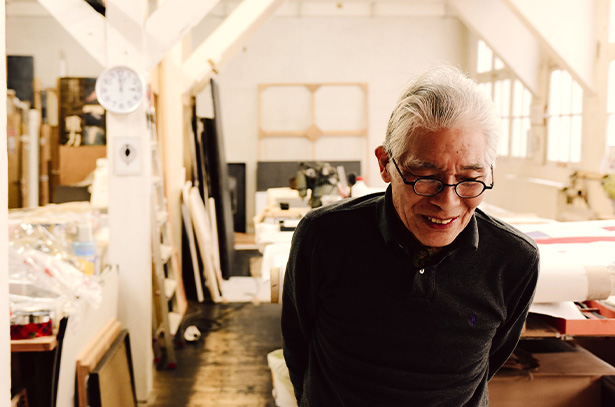Hauser & Wirth Somerset is proud to present its first solo exhibition of works by Japanese-born, Paris-based artist, Takesada Matsutani. The exhibition, which has been organised in collaboration with Olivier Renaud-Clément, includes new paintings and a site-specific installation, alongside a series of never-before-seen assemblages, offering an insight into the breadth of the artist’s practice. In addition a selection of prints dating from the 1960s will be shown in a special Hauser & Wirth Book Lab that focuses on the artist’s book and printmaking.
From the early 1960s to the early 1970s, Matsutani was a key member of the Gutai Art Association (1954 – 1972), Japan’s innovative and influential art collective of the post-war era. Inspired by blood samples he had viewed under a microscope, Matsutani began to develop his signature style of circular, bubble-like forms from blobs of vinyl glue that he deposited on the surfaces of his canvases. By working closely with the material, he embodied an important aspect of Gutai: letting the material and spirit work in conjunction with one another to create something new. In 1966, Matsutani received a grant from the French government after winning first prize in the 1st Mainichi Art Competition, and subsequently moved to Paris where he continues to live and work today. Soon after moving to Paris he began working as assistant to Stanley William Hayter at his renowned Atelier 17, where he devoted himself to the techniques of etching and engraving. One of the most important Japanese artists still working today, Matsutani continues to demonstrate the spirit of Gutai throughout his practice, conveying the reciprocity between pure gesture and raw material.
The first room of the exhibition houses a large site-specific installation entitled, ‘Beginning a drop in time (initiated on-site)’. This piece is related to Matsutani’s work ‘Venice Stream’, shown at the 57th Venice Biennale, and is part of an ongoing series that the artist has been exploring since the late1970s. Suspended in the centre of the room is a hanging sack, full of ink. Matsutani will activate this by piercing the sack during the exhibition’s private view, continuing a long-standing performative aspect of his practice. The ink drips onto a wooden ball placed directly below in the centre of a white wooden board. With time, the splashes form a halo, evoking movement, process and rhythm. Three large monochromatic tondos hang from the rafters, lending the space a contemplative, almost chapel-like atmosphere. Two of the tondos hang back-to-back inviting the viewer to pass under or around them.
Moving into the workshop gallery, a group of new paintings are on view. Working with acrylic and vinyl adhesive on canvas, these bold, colourful paintings have strong ties to the artist’s Gutai period, when he began experimenting with vinyl glue (newly on the market in Japan at that time). The glue is poured onto the canvas, then dried to create a skin, which Matsutani inflates using his own breath, to create swollen and ruptured forms, evocative of flesh and wounds. In these new paintings, Matsutani is revisiting the bold colour palette he first explored in the late 1960s and early 1970s, when he was playing with hard edge abstraction in paintings and prints.
The work ‘Blown Up 15’ (2015) occupies the Pigsty gallery. In this piece graphite saturates the surface of the paper, a technique Matsutani began using in the mid 1970s. With the Gutai group’s spirit of breaking new ground at the forefront of his mind, he began to consider the origins of drawing, paring it back to its barest component parts of pencil and paper. He was exploring what surface could emerge out of an accumulation of repeated pencil strokes – a practice he has continued over the last 40 years. As the deep blackness began to materialize, the process became almost diary-like, each stroke upon stroke and the deepening tone, representing the passing of time. His zen-like approach to these simple materials and the meditative repetition of the strokes allowed Matsutani to consider their connection to his Japanese heritage.
The final room in the exhibition contains a group of small, wall-mounted assemblages created using a range of materials and found objects including vinyl adhesive, plastic, graphite pencil, wood and cardboard. Evoking notions of the erotic or surreal, these intriguing works initiate investigations between soft and hard material forms. The softness of the glue is countered by the hard objects, yet it’s ability to absorb them allows for organic shapes to emerge, achieving a balance.
‘Propagation 5’ (1967), a print made during Matsutani’s first year at Atelier 17 is also included in the final room, shown alongside the original copper plate. During this period Matsutani explored various techniques including etching, aquatint and silkscreen. This important body of work offers a fascinating counterpoint to the paintings and is acknowledged by the artist as fundamental to the development of his practice. A line can be traced from the imagery Matsutani first saw when looking at blood cells, through his use of vinyl glue, to the imagery on the copper printing plates – he is always investigating the cycle of life, death and rebirth, and a universal truth that resides in the state of flux.
The Hauser & Wirth Book Lab is a project devoted to exploring the important place that books and prints occupy in the practice of artists. Alongside the exhibition a Book Lab inspired by Matsutani’s interaction with books takes the ‘artist book’ as its subject. Included in the Book Lab is a further selection of the artist’s prints dating to his time at Atelier 17. In addition the gallery has organised a series of events inspired by the exhibition, which includes a symposium exploring print and a series of education days in response to the Big Draw Campaign.

















